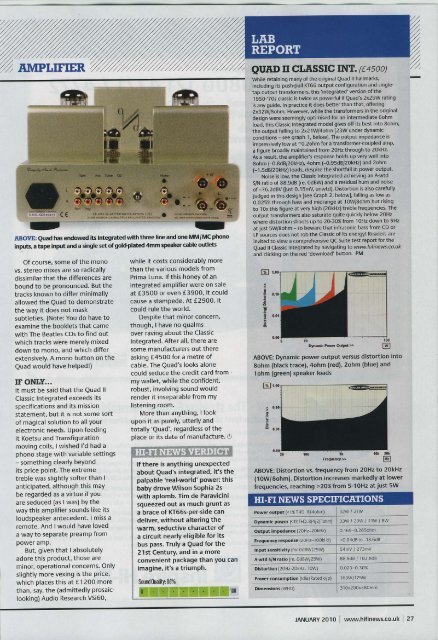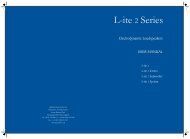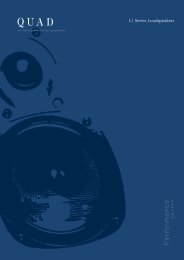Here - Quad
Here - Quad
Here - Quad
Create successful ePaper yourself
Turn your PDF publications into a flip-book with our unique Google optimized e-Paper software.
AMPTIfIER<br />
trr<br />
ABOVE: <strong>Quad</strong> has endorrred tu Integrated with thre€ line and one MM/MC phono<br />
inpuLr, a tape input and a single set of goldflated 4mm speaker cable outlets<br />
Of course, some ofthe mono<br />
vs. stereo mixes are so radicallY<br />
dissimilar that the differences are<br />
bound to be pfonounced. But the<br />
tracks known to differ minimallY<br />
allowed the <strong>Quad</strong> to demonstrate<br />
the way it does not mask<br />
subtleties. (Note: You do have to<br />
examine the booklets that came<br />
with The Beatles cDs to find out<br />
which tracks were merely mixed<br />
down to mono, and which differ<br />
extensively. A mono button on the<br />
<strong>Quad</strong> would have helped!)<br />
IF ONI,Y...<br />
It must be said that the <strong>Quad</strong> ll<br />
Classic lntegrated exceeds its<br />
specifications and its mission<br />
statement, but it i5 not some sort<br />
of magical solution to allyour<br />
electronic needs. Upon feeding<br />
it Koetsu and Transfiguration<br />
moving coils, lwished I'd had a<br />
phono stage with variable settings<br />
something clearly beyond<br />
its price point. The extreme<br />
treble was slightly softer than I<br />
anticipated, although this may<br />
be regarded as a virtue if You<br />
are seduced {as I was) bY the<br />
way this amplifier sounds like its<br />
loudspeaker antecedent. I miss a<br />
remote. And lwould have loved<br />
a way to separate preamP from<br />
power amp.<br />
But, given that labsolutelY<br />
adore this product, those are<br />
minor, operational concerns. OnlY<br />
slightly more vexing is the Price,<br />
which places this at c 1200 more<br />
than, say, the (admittedlY Prosaiclooking)<br />
Audio Research VSi60,<br />
while it costs considerably more<br />
than the various models from<br />
Prima Luna. lf this honey of an<br />
integrated amplifier were on sale<br />
at f3500 or even 83900, it could<br />
cause a stampede. At €2900, it<br />
could rule the world.<br />
Despite that minor concern,<br />
though, I have no qualms<br />
over raving about the Classic<br />
Integrated. After all, there afe<br />
some manufacturers out there<br />
asking f4500lor a metre of<br />
cable. The <strong>Quad</strong>'s looks alone<br />
could seduce the credit card from<br />
my wallet, while the confident,<br />
robust, involving sound would<br />
render it inseparable ffom mY<br />
listening room.<br />
More than anything, I look<br />
upon it as purely, utterly and<br />
totally '<strong>Quad</strong>', regardless of the<br />
place or its date of manufacture. O<br />
';,:'ii;.;lt,i ,f '<br />
'.l. i ,'..1;r.,<br />
1,'I<br />
lI there is anything unexpected<br />
about <strong>Quad</strong>'s integrated, it's the<br />
palpable'reafwodd' Power: this<br />
baby drove Wilson soPhia 2s<br />
with aplomb. Tim de Paravicini<br />
squeezed out as much grunt as<br />
a brace of KT66s-Per-side can<br />
deliver, without alterinq the<br />
warm, seductive character of<br />
a circuit nearly eligible for its<br />
bus pass. Truly a <strong>Quad</strong> for the<br />
21st Century, and in a more<br />
convenient package than You can<br />
imagine, it's a triumph.<br />
Sound 0uatity: 860/o<br />
QUAD II CLASSIC lNT. E45oo)<br />
Whileretaining manyof the original <strong>Quad</strong> ll hallmarks'<br />
including its push_pull KT66 output configuration and singleta<br />
D outout transformeE, this 'integrated' version of the<br />
1950r7os classic k twice as powerfLll if <strong>Quad</strong>'s 2x25W ratinq<br />
is any guide. In practice it does betterthan that, offering<br />
2x32W8ohm. However, while the tta nsformers in the original<br />
design were seemingly optimked for an intetmediate 6ohm<br />
load, this Classic Integrated mod€l gives off its best into Sohm'<br />
the outputfalling to 2x21q4ohm i23W underdynamic<br />
conditions - s€e graph 1, belowl.The outPut impedance k<br />
imoressivelv low at "0.2ohm for a transformercou pled amp'<br />
a figure broadly maintained from 2OHzthrough to 2okHz.<br />
As a result. the amplifiels response holds up verywell into<br />
Sohm (-0.8d B/2okHz), 4ohm (-0 95d8/20kHz)and 2ohm<br />
{-1.5dB/2okHzloads, despitethe shortfall in power output<br />
Noise is lowthe classic Integrated achieving an A-\^/td<br />
S/N tatio of 88.SdB (re. OdBW) and a tesidual hum and noise<br />
of-76.2d8V (just O.1smv unwtd). Distortion is also carefully<br />
judged in this design isee Graph 2, belowl, falling as low as<br />
0.025%throuqh bass and m;drange at low/8ohm but dsinq<br />
to 1Ox this figurc at very high {20kHz)treble frequencies. The<br />
output transformers also saturate quite quickly below 2oHz<br />
where distortion shoots up to 20_30%<br />
ftom 10 Hz down to 5 Hz<br />
at iust 5w8ohm -so bewaretfut infrcsonic bassfrom CD or<br />
LP sources does not robthe Classic of its enetgy! Reade6 are<br />
invited tovjew a comprehensive QC Suite test report forthe<br />
<strong>Quad</strong> ll Classic fntegrated by navigating to wv'rw.hifinews.co.uk<br />
and clicking on tbe ted 'download' button. PM<br />
trl<br />
z!<br />
E<br />
Dyrtuic Pov.r oual, >><br />
E<br />
ABOVE: Dynamic power output versus distortion into<br />
8ohm {black trace),4ohm (red}, 2ohm (blue} and<br />
lohm (green) speaker loads<br />
E<br />
Fr.qu.ncy>><br />
l!!l<br />
ABOVE: Distortion vs. frequency from 20Hz to 2OkHz<br />
(1OW/8ohm). Distortion increases markedly at lower<br />
frequencies, reaching >2o%from 5-10H2 atjust 5W<br />
Power output (





